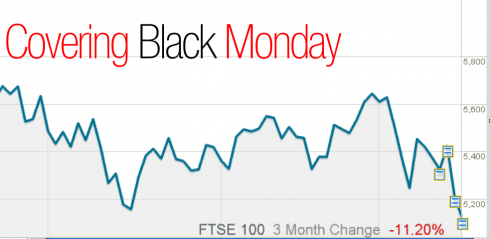

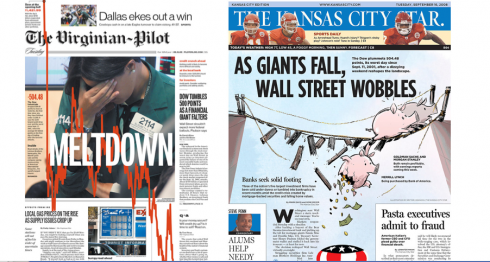
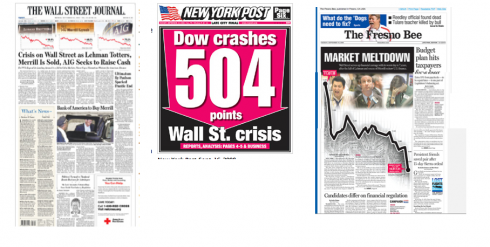
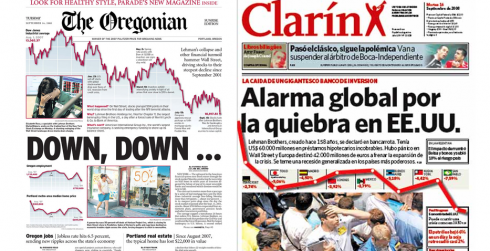
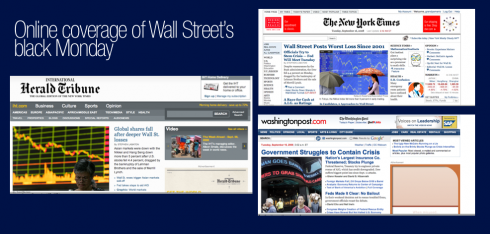
When one sees a yellow banner running over page one of the International Herald Tribune, one knows the news is big—-and it usually spells trouble. As on today’s front page: Upheaval on Wall Street.
The normally staid from page of thestro IHT displays a fever chart indicating the market’s trajectory from January 08 to yesterday, a downward spiral that tells the story before we read the headline: Crisis rattles markets and nerves. Then, the local angle for the European audience—-Storm rising, Europe fears it’s in the same boat.
Also in the same boat, front pages from other well known European dailies for all of which this was, unquestionably, the big story of the day—-perhaps of the week. With shares sliding around the globe following the fall of Lehman Brothers, the takeover of Merrill Lynch, and the plea for government help from the giant American International Group, this was the definitive page one lead item.
Online editions also updated the story constantly, but the emphasis here was more on photos than on graphics.
One week later: Yale Daily News thriving
Happy news from our friends in the Yale Daily News
newsroom. One week after launch of the YDN, the staff becomes comfortable with the new design, and the front page shown here shows it.
Reed Reibstein, who has worked with Dr. Pegie Stark Adam and me during the entire summer on this redesign, and who manages production for the team, writes us:
And last night was the first night that I did not come into the YDN to answer questions or troubleshoot; the design is now self-sufficient! The past week, on the design side, has seen solid pages that stay within the stylebook, aside from some minor issues here and there that we have largely addressed during nightly critiques. The inside pages have looked good, with appropriate white space—and they have consistently passed informal dollar tests! The two issues of scene have also been executed nicely, with airy pages and some dynamic headlines.
A front page that worked well
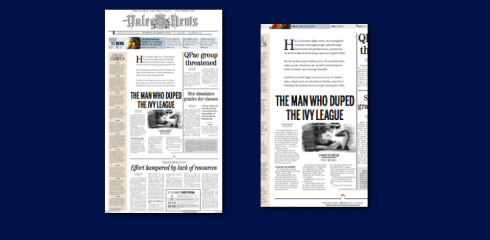
Reed sends us a pdf of a special front page that truly got it all together according to plan:
Last Wednesday, we ran a 130-inch feature on the student who falsified his Yale application and was only discovered in his junior year. The story may have been extremely long, but it was more like a magazine’s cover story and needed the full length to tell the former student’s tale properly. For the front, we placed much of the beautifully-written intro above the headline, which was set in our Sans Headline option as “THE MAN WHO DUPED THE IVY LEAGUE.” Below we had a pencil sketch of the former student. While the rest of the front lacked color and was not particularly interesting, the centerpiece was so powerful and captivating that I feel it carried the whole page and the whole issue. I hope that with continued encouragement and practice we can improve, to consider our stories as much as we considered this one.
Great job, Reed and team. This one front page shows how the design can evolve, so that you can display stories such as this one, and surprise the reader, both journalistically and visually. Bravo.
Needed: human touch in “the path of the story”
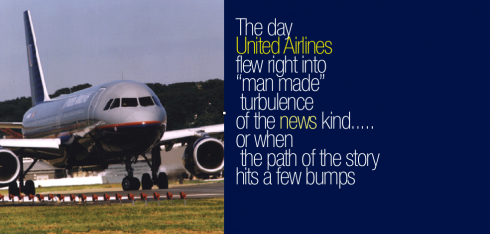
We often discuss breaking news and strategies that help to smooth out the path of a story and how it travels from online to print and back to online.
It is, indeed, a timely subject and one that needs to be continuously discussed in newsrooms globally.
Perhaps it is important to emphasize the importance of the role of an editor in the process, however.
Take, for example, the case of a recent news gaffe involving United Airlines, which cost that firm a swift and , mercifully, short-lived collapse of its shares Sept 8. Investors wiped out $1 billion of the market value of UAL within minutes of an erroneous news flash on Bloomberg screens about a United bankruptcy.
According to the International Herald Tribune, “Google and the Tribune Co., the owner of The South Florida Sun-Sentinel, whose Web site was the source of the article that led to the headline, soon blamed each other for causing the fiasco.”
What happened?
United did file for bankruptcy in 2002. However, on September 7 of this year, after midnight, a link to an article headlined “United Airlines Files for Bankruptcy, “ which was originally published in The Chicago Tribune of 2002, appeared in the “Most Viewed” box on the main business page of The Sun-Sentinel’s site.
Within a minute, reports the IHT, the automatic scanninc system of Google News, which visits more than 7500 news sites every 15 minutes to pick up material, found the link and followed it to the article page in The Sun-Sentinel archives. Google’s system then interpreted the article to be new, adding it to its news index. The next morning, an employee of Income Security Advisors, a financial information company, saw the article after searching Google for recent bankruptcies. The employee sent out a summary of the article via the Bloomberg service. Bloomberg’s news service subsequently flashed a headline about it, citing the Sun-Sentinel report. Within minutes, United shares crashed.
The missing ingredient?
This incident—-costly for United shareholders, who may now have to recover their losses in court—-indicates that in a today’s fast breaking news cycles, with thousands of news sites archiving and dispensing news, it is imperative that the path of the story is monitored internally by an editor; true, mistakes like the one described here are going to be inevitable, but perhaps human participation would reduce the number of such mistakes, or make them more easily corrected.
Next trend: the vanity newspaper
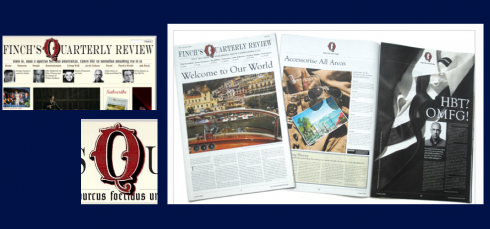
Luxury is a topic we often discuss in this forum. Indeed, despite the downturn in the economy, luxury advertising continues to rise, and the desire for luxury items does not seem to be connected in any way to the fate of Wall Street—-as described in the items above about coverage of yesterday’s Black Monday in the global stock market.
Now Charles Finch launches the premiere edition of his newspaper, Finch’s Quarterly Review, which he describes as a “celebration of an old world and a desire to applaud the finer things in life.”
The 32-page first issue of the newspaper includes articles by such Hollywood celebs as John Malkovich, Kevin Spacey and Emma Thompson.
Articles guide the reader thru such topics as “selecting the right cufflinks” and how to get a table at a group of selected restaurants IF you failed to get a table at the exclusive Waverly Inn in New York.
Not to mention decadent tips as in The Perfect Cocktail for Summer. Yes, the dry martini it is:
We’re talking dirty. Really dirty. This is no time for your colonial Bond classic, your streamlined Churchillian silver bullet, or your silky Somerset Maugham, stirred so as not to bruise the gin. Summer is the season for their roguish, roughed up cousin who filches juniper berries down a country lane with scabs on his knees and a sour, disenchanted smile. The gin-spiked brine of a dirty martini captures all the true, salty tastes of native estivation, from the gritty chill of childhood mornings endured on an east coast beach to the tarmac tartness of a long afternoon spent lingering on a polluted Soho street. Particularly potent late in the season as the days retreat into an idealised, nostalgic haze, its smoky aftertaste exactly smacks of our grey, receding sea.
If you wonder who Charles Finch is——I know I did—- he is the son of the late actor Peter Finch, and runs a London-based consultancy specializing in advising artists, brands and cultural institutions. Yes, the paper sells for 10 euros, and is available by subscription only on the website: www.finchsquarterly.com
Which goes to show that, as we have said often here, the printed newspaper is not going to disappear soon. And, in fact, we will probably see a trend for more vanity newspapers. Today, when everyone can turn into an instant news analyst, commentator, journalist or photographer, who is to say one cannot also become a newspaper publisher? If having your own website and/or blog is not sufficiently satisfying, why not start your own newspaper?
Charles Finch paves the way.
Paging Tyler Brulé
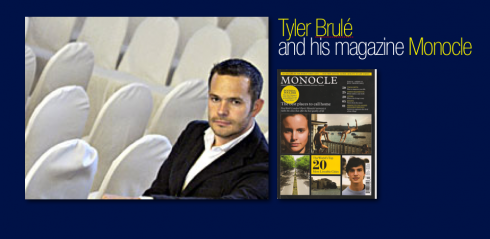
In fact, I am surprised that good friend Tyler Brulé, editor and publisher of Monocle magazine, and revered columnist for the weekend edition of the Financial Times, has not reviewed Finch’s newspaper. Or have I missed it? Tyler, this would be a review your readers would appreciate tremendously, especially if you were to discover and to review other vanity newspapers from around the world.
![]()
In scenic, but rainy and cool, Vienna, the rest of the week, working with the online/print team of the Wirtschafts Blatt, the financial daily here; an interesting project to continue to further integrate online/print editions. Subject of this week’s workshop and discussions: how to avoid cannibalization of print/online. Establishing good working rules in the newsroom. We began this process six months ago at the WB, and now I visit periodically to monitor progress, and to concentrate on specific case studies. Editors of both online/print gather and discuss how a certain breaking news item was covered by both online and print editions, evaluating results and establishing criteria and strategies for the future.
TheMarioBlog posting #94